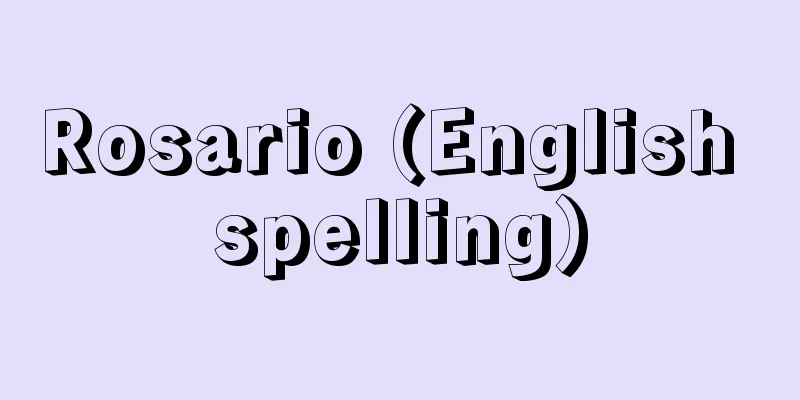Rosario (English spelling)

|
A city in the southeastern part of Santa Fe Province in north-central Argentina. It is the third largest city in the country, located about 260 km northwest of the capital, on the west bank of the lower Paraná River. A settlement formed on the floodplain of the Paraná River from the end of the 17th century was rebuilt as Rosario in 1725, and is known as the place where General M. Belgrano first raised the national flag in 1812 during the War of Independence from Spain, but it was only a small village until the middle of the 19th century. It developed rapidly after being designated a major port for the inland provinces by President J. Urquiza in 1956. Since the beginning of the 20th century, its status as a trading port has declined somewhat since water transportation began to concentrate in the capital, but the port with modern port facilities can receive ocean-going ships sailing up the Rio de la Plata, and it is important as an export port for agricultural and livestock products from the fertile agricultural and pastoral areas of the Gran Chaco and Pampas behind it. Its main exports are wheat, feed, corn, sugar, rum, cattle, leather, meat, and tannins. The city has also seen remarkable industrial development, and is currently home to a variety of industries, primarily agricultural processing, making it one of the country's leading industrial cities. It is also the main trading port for landlocked Bolivia. It is also home to the National University of Rosario (1968). In addition to water transportation, it is also a key location for land transportation, with railways and roads extending from the city to various parts of the country. Population: 935,471 (1980). Source: Encyclopaedia Britannica Concise Encyclopedia About Encyclopaedia Britannica Concise Encyclopedia Information |
|
アルゼンチン中北部,サンタフェ州南東部の都市。同国第3の大都市で,首都の北西約 260km,パラナ川下流部西岸に位置する。パラナ川の氾濫原に 17世紀末頃から形成された集落が,1725年ロサリオとして再建され,スペインからの独立戦争時,1812年に M.ベルグラノ将軍により初めて国旗が掲げられた地として知られるが,19世紀なかばまでは小村にすぎなかった。 56年 J.ウルキサ大統領により内陸部諸州のための主要港に指定されてから急速に発展。 20世紀に入って水運が首都に集中するようになってから貿易港としての地位はやや低下したが,近代的な港湾施設を備えた港はラプラタ川から遡航する外洋船が入港でき,背後のグランチャコやパンパスの肥沃な農牧地帯に産する農畜産物の輸出港として重要。主要輸出品は小麦,飼料,トウモロコシ,砂糖,ラム酒,ウシ,皮革,食肉,タンニンなど。また工業面での発展も著しく,現在農産物加工を中心とした各種工業が立地し,同国有数の工業都市となっている。内陸国ボリビアの主要貿易港でもある。国立ロサリオ大学 (1968) 所在地。水運のほか,陸上交通の要地でもあり,市から国内諸方面へ鉄道,道路が延びている。人口 93万 5471 (1980) 。
出典 ブリタニカ国際大百科事典 小項目事典ブリタニカ国際大百科事典 小項目事典について 情報 |
<<: Rosary - Rosario (English spelling) Rosarium (Latin)
>>: Vasiliy Vasil'evich Rozanov
Recommend
Hitoyado - Hitoyado
〘noun〙① A place where people can stay. Hatagoya. I...
Sergei Semyonovich Uvarov
1786‐1855 A Russian scholar of classical literatur...
Saururus
…A perennial herb of the Houttuynia family that g...
IGY - Integrative Geometry
《 International Geophysical Year 》⇒International G...
autoroute
...Also, the Shuto Expressway and the Hanshin Exp...
Joining - New
〘Noun〙① To enter a territory. In particular, when ...
Suzuka Pass
An ancient checkpoint located in Ise Province (ne...
Musical note name
A proper name for each note in a sound system, de...
Fukuwarai - Fukuwarai
A type of paper toy (gangu). It consists of a pie...
Rill erosion (English spelling)
…Rain wash is the process by which rainwater dire...
Snow cave - Setto
〘Noun〙① A wooden or bamboo frame covered with whit...
Blackbuck - blackbuck (English spelling)
An animal of the order Artiodactyla, family Bovid...
Esuti tribe - Esuti tribe
The Uralic language family is a collective term f...
Map of all countries - Bankokuzu
A map depicting the countries of the world. From t...
Oki Island
An island with an area of approximately 0.69 km2...









